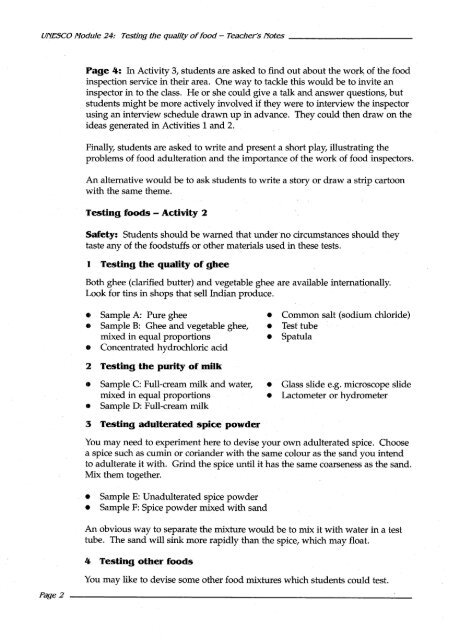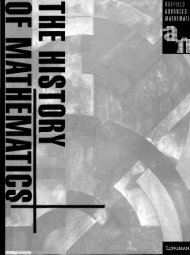UNESCO resource kit - science and technology educa...
UNESCO resource kit - science and technology educa...
UNESCO resource kit - science and technology educa...
Create successful ePaper yourself
Turn your PDF publications into a flip-book with our unique Google optimized e-Paper software.
<strong>UNESCO</strong> Module 24: Testing the quality of food - Teacher's Notes _<br />
Page 2<br />
Page 4: InActivity 3, students are asked to find out about the work of the food<br />
inspection service in their area. One way to tackle this would be to invite an<br />
inspector in to the class. He or she could give a talk <strong>and</strong> answer questions, but<br />
students might be more actively involved if they were to interview the inspector<br />
using an interview schedule drawn up in advance. They could then draw on the<br />
ideas generated in Activities 1 <strong>and</strong> 2.<br />
Finally, students are asked to write <strong>and</strong> present a short play, illustrating the<br />
problems of food adulteration <strong>and</strong> the importance of the work of food inspectors.<br />
An alternative would be to ask students to write a story or draw a strip cartoon<br />
with the same theme.<br />
Testing foods - Activity 2<br />
Safety: Students should be warned that underno circumstances should they<br />
taste any of the foodstuffs or other ma~erials used in these tests.<br />
1 Testing the quality of ghee<br />
Both ghee (clarified butter) <strong>and</strong> vegetable ghee are available internationally.<br />
Look for tins in shops that sell Indian produce.<br />
•• Sample A: Pure ghee<br />
• Sample B: Ghee <strong>and</strong> vegetable ghee,<br />
mixed in equal proportions<br />
• Concentrated hydrochloric acid<br />
:! Testing the purity of milk<br />
• Sample C: Full-cream milk <strong>and</strong> water,<br />
mixed in equal proportions<br />
4. Sample D: Full-cream milk<br />
;3 Testing adulterated spice powder<br />
• Common salt (sodium chloride)<br />
• Test tube<br />
• Spatula<br />
• Glass slide e.g. microscope slide<br />
• Lactometer or hydrometer<br />
You may need to experiment here to devise your own adulterated spice. Choose<br />
a spice such as cumin or cori<strong>and</strong>er with the same colour as the s<strong>and</strong> you intend<br />
to adulterate it with. Grind the spice until it has the same coarseness as the s<strong>and</strong>.<br />
Mix them together.<br />
• Sample E: Unadulterated spice powder<br />
• Sample F: Spice powder mixed with s<strong>and</strong><br />
An. obvious way to separate the mixture would be to mix it with water in a test<br />
tube. The s<strong>and</strong> will sink more rapidly than the spice, which may float.<br />
4- Testing other foods<br />
You may like to devise some other food mixtures which students could test.

















